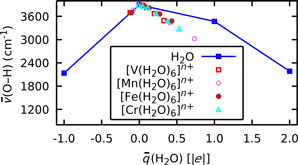Crossref Citations
This article has been cited by the following publications. This list is generated based on data provided by
Crossref.
Koch, Daniel
Chen, Yingqian
Golub, Pavlo
and
Manzhos, Sergei
2019.
Revisiting π backbonding: the influence of d orbitals on metal–CO bonds and ligand red shifts.
Physical Chemistry Chemical Physics,
Vol. 21,
Issue. 37,
p.
20814.
Nazmutdinov, R. R.
Zinkicheva, T. T.
Kolpakov, M. E.
and
Dresvyannikov, A. F.
2019.
Quantum Chemical Modeling of Electrochemical Consecutive Reduction of Fe(III) Aqua- and Aqua-Hydroxocomplexes.
Journal of Structural Chemistry,
Vol. 60,
Issue. 8,
p.
1226.
Koch, Daniel
and
Manzhos, Sergei
2020.
Oxygen Redox Activity in Cathodes: A Common Phenomenon Calling for Density-Based Descriptors.
The Journal of Physical Chemistry C,
Vol. 124,
Issue. 37,
p.
19962.
Koch, Daniel
Chen, Yingqian
Golub, Pavlo
and
Manzhos, Sergei
2020.
Reply to the ‘Comment on “Revisiting π backbonding: the influence of d orbitals on metal–CO bonds and ligand red shifts”’ by G. Frenking and S. Pan, Phys. Chem. Chem. Phys., 2019, 22, DOI: 10.1039/C9CP05951B.
Physical Chemistry Chemical Physics,
Vol. 22,
Issue. 9,
p.
5380.
Koch, Daniel
and
Manzhos, Sergei
2020.
Ab initiomodeling and design of vanadia-based electrode materials for post-lithium batteries.
Journal of Physics D: Applied Physics,
Vol. 53,
Issue. 8,
p.
083001.
Koch, Daniel
Chaker, Mohamed
Ihara, Manabu
and
Manzhos, Sergei
2021.
Density-Based Descriptors of Redox Reactions Involving Transition Metal Compounds as a Reality-Anchored Framework: A Perspective.
Molecules,
Vol. 26,
Issue. 18,
p.
5541.
D’Arpino, Alexander A.
Cundari, Thomas R.
Wolczanski, Peter T.
and
MacMillan, Samantha N.
2023.
Transition Metal Nitrosyls: Statistics, Charge Estimates via CDVR, and Studies of Tetradentate Chelate Diamides (pddi)M and (pddi)MNO (M = Cr, Fe, and Co).
Organometallics,
Vol. 42,
Issue. 19,
p.
2747.
Wolczanski, Peter T.
2024.
Elemental Aspects of Transition Metals Pertinent to Organometallic Chemistry: Properties, Periodicity, Curiosities, and Related Main Group Issues.
Organometallics,
Vol. 43,
Issue. 8,
p.
787.
Koch, Daniel
Pavanello, Michele
Shao, Xuecheng
Ihara, Manabu
Ayers, Paul W.
Matta, Chérif F.
Jenkins, Samantha
and
Manzhos, Sergei
2024.
The Analysis of Electron Densities: From Basics to Emergent Applications.
Chemical Reviews,
Vol. 124,
Issue. 22,
p.
12661.
